10 Most Famous Caravaggio Paintings
Michelangelo Merisi or Amerighi, oft known as 'Caravaggio,' was a well-known European artist who is mayhap the virtually renowned Bizarre painter who ever lived.
His paintings are characterized by a strong contrast between light and shadow, which became a hallmark of Baroque painting.
He was built-in in Milan in 1571, but his family relocated to a place in Italian republic known as Caravaggio simply a few years later to escape the plague'south ravages.
As a young adult, he returned to Milan and studied under Simone Peterzano, a well-known painter of the age.
Michelangelo Merisi da Caravaggio went to Rome after successfully trained as a painter in Milan. This is where he started and spent the about of his creative career.
Caravaggio is credited with inventing Tenebrism, a renowned style in baroque painting. This approach is distinguished by its utilize of mostly black tones and shadows combined with spectacular lite contrast furnishings.
Autonomously from Tenebrism, he was well-known for portraying pivotal events and situations, which often included violent conflicts, harsh penalty, and decease.
His paintings combined a realistic portrayal of physical and emotional states with dramatic lighting, influencing the bizarre schools of painting.
Caravaggio is oft referred to as the "Father of Painting." His influence may exist seen both straight and indirectly in the piece of work of Rubens, Jusepe de Ribera, Bernini, and Rembrandt.
Below are some of Caravaggio's most famous paintings that have firmly cemented him as one of the great masters.
Famous Caravaggio Paintings
ane. The Calling of Saint Matthew
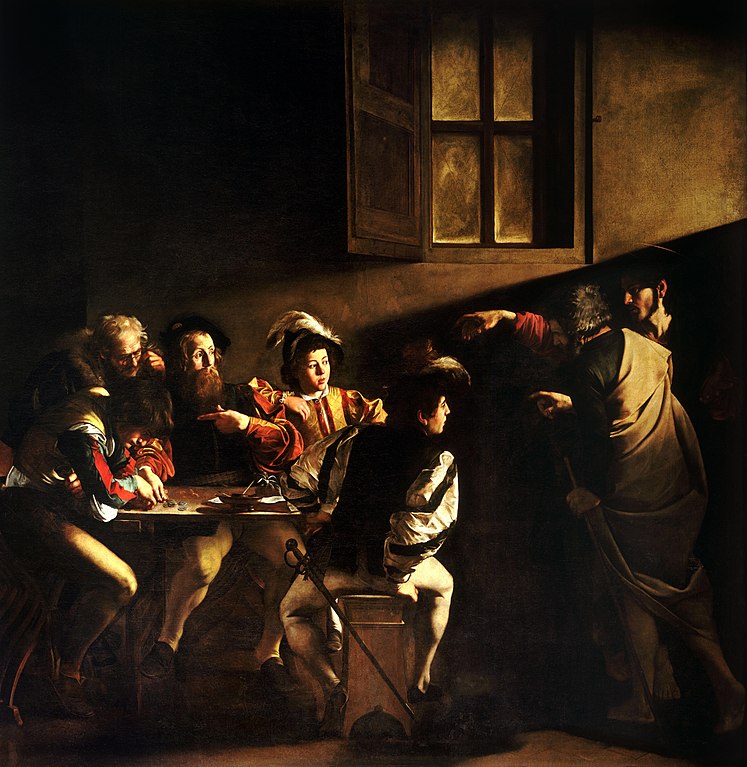
Few painters are also recognized for their ability to depict loftier degrees of light and night as Caravaggio. His masterpiece, The Calling of St. Matthew, was finished in 1600 and contains a compelling Biblical scenario in which Jesus asks Matthew to follow him.
The painting has received widespread appreciation for its extraordinary realism every bit well as the emotions plain shown in the characters in the picture.
Jesus is shown gesturing to Matthew, who is seated at the table of Roman tax collecting, a vocation that was frowned upon by Jews at the period.
Matthew is represented with a horrified look in response to Jesus' asking, since revenue enhancement collectors were often seen as traitors to the Jewish religion.
two. Judith Beheading Holofernes
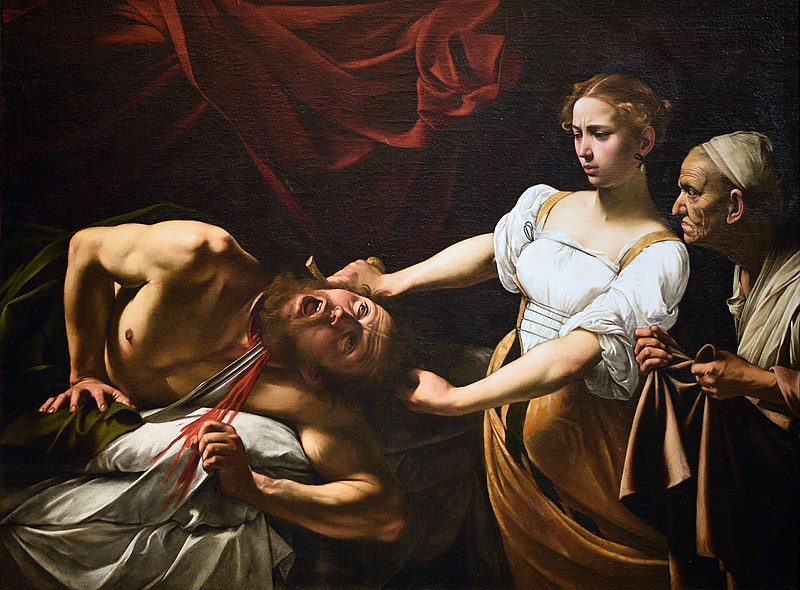
Caravaggio was famed for his ability to create paintings that accentuated the dissimilarity between calorie-free and darkness, which plainly represent good and evil in many of his about famous works.
In 1599, he completed one of his most notable pieces, Judith Beheading Holofernes, which the artist named Judith Beheading Holofernes.
The picture show is based on the One-time Testament tale of Judith slaying the Assyrian monarch after luring him into a false feeling of security.
The pic was praised for its farthermost degree of realism in every infinitesimal item, from the look on Judith's confront to Holofernes' writhing in misery.
The artwork depicts a shocked Holofernes who is taken aback by his fate at the hands of a lovely and fragile lady such as Judith. Abra, her elderly maid, appears backside her, clutching a blanket that she virtually likely meant to use to conceal Holofernes' face.
The elements of low-cal and darkness are brilliantly utilized in this piece to stand for the victory of good over evil in Judith's modest act of final revenge.
3. The Taking of Christ
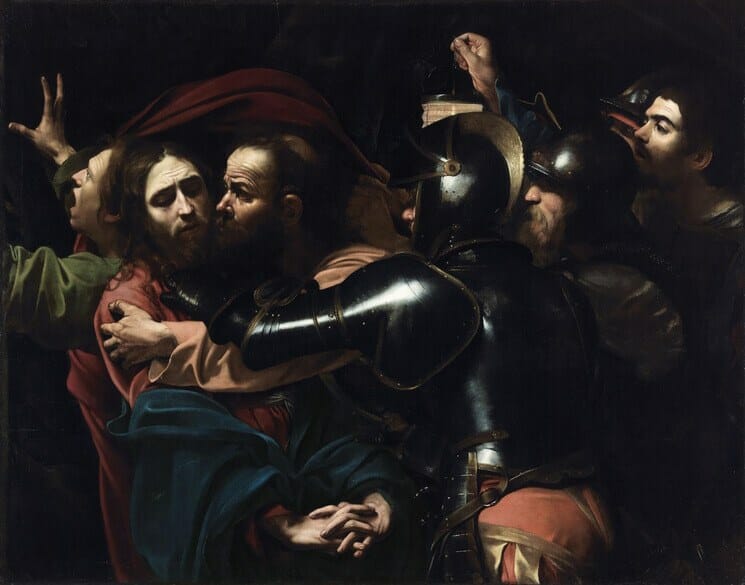
Caravaggio created this remarkable painting in 1602 for the Roman Marquis Ciriaco Mattei. Caravaggio used a novel visual approach to the biblical tale by positioning the characters close to the movie plane and using a sharp dissimilarity of light and dark, imbuing the scene with an incredible sense of drama.
Equally the temple guards approach to capture Christ, Judas has identified Him with a osculation. St John the Evangelist is the fleeing disciple in disorder on the left. The scene is illuminated only past the moon.
While the homo on the far right is carrying a lantern, it is ineffectual as a light source. Caravaggio represented himself, aged 31, as a spectator of events in that human's face, a tactic he regularly used in his works.
The picture show, completed in 1602, depicts one of the nearly terrible moments in Christ's life, when he was apprehended by members of the Jewish hierarchy who would ultimately execute him. Jesus' portrayal illustrates his empathetic and nonviolent demeanor in the face of individuals enraged by his teachings.
Caravaggio's portrayal of Jesus is astoundingly realistic, and the creeping darkness that surrounds him as he is arrested signifies the inevitability of his ain fate.
4. Basket of Fruit
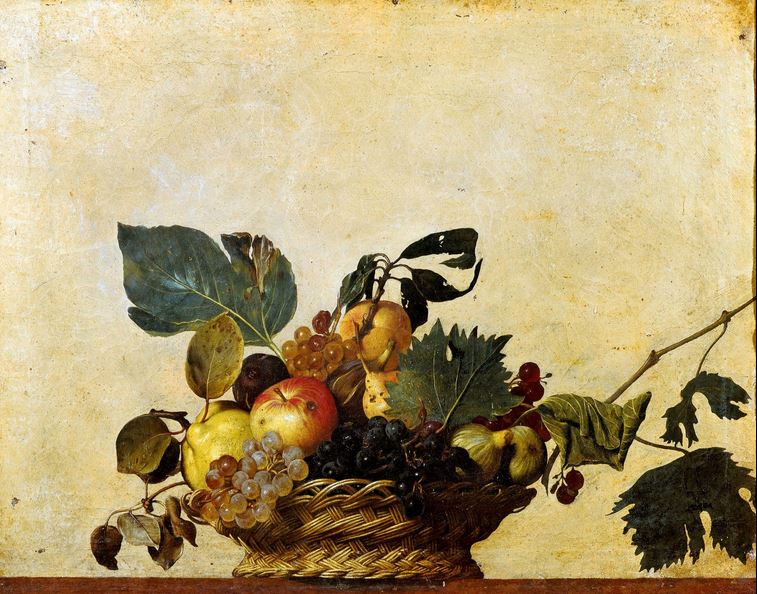
Recognized for his expertise in painting situations that display strong contrasts betwixt light and nighttime, the Italian Baroque painter Michelangelo Merisi da Caravaggio is best known for his work in the genre of chiaroscuro.
His painting Still Life with a Basket of Fruit is considered to exist ane of the best fruit paintings ever created, and information technology demonstrates the artist's ability to capture differences in low-cal and shadow while working with a variety of hues.
This piece, which was painted in 1599, was one of the artist's rare still life paintings, since he mostly concentrated his efforts on sacred subjects from Christianity. The picture, which is on exhibit in a library in Milan, Italian republic, has piqued the interest of fine art aficionados and critics alike considering of its unusual depiction of fruit.
Caravaggio painted a bones basket of fruit resting on a table that looks to be relatively unproblematic at beginning sight, just a closer inspection shows that the fruits painted on the painting take deteriorated to strange degrees.
I or 2 of the leaves accept been chewed through by a little worm and most of the fruit, including the grapes, seems to accept passed their ripening bespeak and is beginning to rot.
On closer scrutiny, the fruit displays some unpleasant traits, which suggests that the creative person was using the fruit as a metaphor of sorts. The fruit seems to be gorgeous, just upon closer investigation, it reveals some bad characteristics.
5. The Beheading of Saint John the Baptist
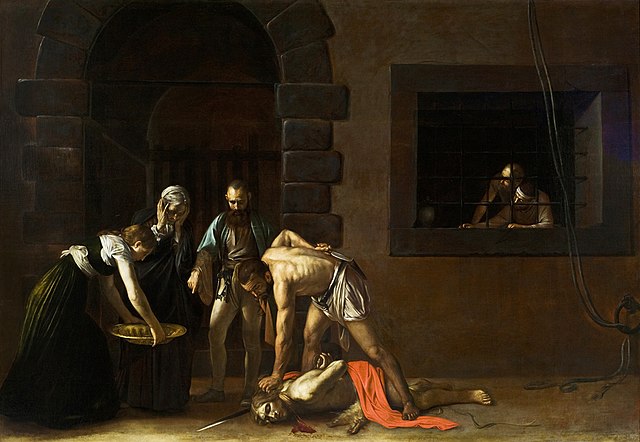
The Beheading of Saint John the Baptist is a three.vii g by v.2 m oil painting depicting John the Baptist's beheading. It is presently housed at Valletta, Malta's Oratory of St. John's Co-Cathedral.
With the use of chiaroscuro, the big canvas emphasizes the vibrant cerise and warm gilded hues associated with the Baroque era. The artwork portrays John the Baptist being executed, as a servant daughter waits nearby holding a gold plate to receive his head.
Another lady, who has been identified as Herodias or merely a spectator who notices something is wrong with the execution, sits past in stunned silence as a jailer provides orders and the executioner pulls his knife to complete the beheading.
6. Bacchus
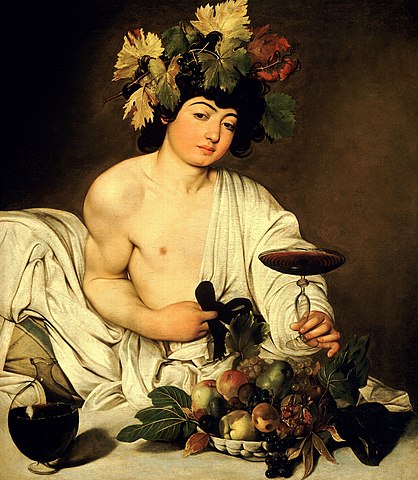
Bacchus (almost 1596) is a Primal Del Monte-deputed oil painting. Bacchus as a youngster is seen in the artwork, lounging classically with grapes and vine leaves in his hair and little with the drawstring of his loosely draped robe.
A dish of fruit and a huge carafe of ruddy wine are set earlier him on a stone table. He invites the audition to join him, holding out a short cup of the same vino. In the moment, the artwork is on display at Florence'due south Uffizi Gallery.
Bacchus was painted before long after Caravaggio entered the household of Key Del Monte, and represents the Central's educated circle's humanist concerns. In 1596, Caravaggio came into the Palazzo Madama and stayed for five years as a cardinal'south guest. Del Monte was an art enthusiast and commissioned many Caravaggio works, including Medusa.
The cardinal was a devotee of traditional Greek mythology and ofttimes employed emblematic symbols to demonstrate his appreciation for art, music, and drama. Bacchus and Medusa were both gifted to the Medici family by the cardinal and have since stayed in Florence.
Del Monte's early on encouragement and direction helped Caravaggio achieve riches and notoriety, making him one of his well-nigh significant benefactors.
seven. David with the Head of Goliath
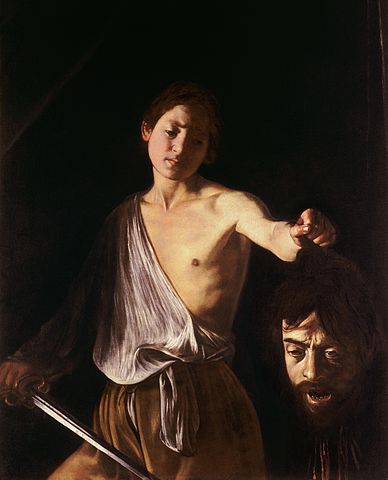
Co-ordinate to art historians, David with the Head of Goliath is a cocky-portrait by Caravaggio. Co-ordinate to some, both figures are emblematic of Caravaggio, with the youthful David portraying a young Caravaggio and the severed and bloodied head of Goliath depicting Caravaggio as an developed.
The picture is presently on exhibit in Rome'southward Galleria Borghese, where it has been since it was delivered there by a contrite Caravaggio pleading with the Pope to remove the toll on his head. The Pope granted his request, just Caravaggio died of a fever shortly after learning virtually it.
A painting by a disciple of Giorgione (1510) depicting a figure reclining on a ledge served as an influence for the creative person. Caravaggio, on the other mitt, more successfully conveyed the drama by representing the head hanging from David's gloved paw, rather than leaving it on a ledge.
David'due south weapon is non the famed sling from the Biblical account, merely rather Goliath'southward ain sword, which David used confronting him. The inscription on the blade reads H-AS Bone, which is an acronym for the Latin phrase "humilitas occidit superbiam" ("humility slays pride").
viii. Narcissus

Narcissus was painted betwixt 1597 and 1599 and was not credited to Caravaggio until 1916 past Roberto Longhi.
This is ane of only 2 Caravaggio paintings known to depict a topic from Classical mythology, albeit this is more than owing to chance than the artist's output.
Co-ordinate to Ovid'due south Metamorphoses, Narcissus is a gorgeous beau who falls in honey with his own reflection. He succumbs to his want, unable to pull himself abroad, and even every bit he crosses the Styx, he continues to wait at his mirror.
Caravaggio depicted a juvenile page wearing a magnificent brocade doublet, leaning over the river with both hands, gazing at his own distorted image.
The film exudes a deep melancholy: Narcissus is imprisoned in a circumvolve with his reflection, surrounded by darkness, implying that the merely reality exists within this self-referential loop.
nine. Medusa

Caravaggio fabricated two renditions of Medusa – one in 1596 and another in 1597 – representing the precise moment she was slain by Perseus. He plays with the notion by substituting his own confront for Medusa'south, indicating his immunity to her horrible stare.
Co-ordinate to fable, the painting's odd and elaborate design complements Caravaggio's singular concern with brutality and reality. Information technology was deputed by Italian ambassador Francesco Maria del Monte in society to present it to the One thousand Knuckles of Tuscany and is currently housed in Florence's Uffizi Museum without being signed.
Caravaggio based his topic on the Medusa tale. The flick represents the severed head of Medusa, a monster depicted as a female with statuary hands and gilded wings who wore a caput full of deadly snakes in lieu of her own hair. Anyone who only stared at her would be rendered immobile.
Medusa, along with her ii sisters Stheno and Euryale, was referred to in ancient Greek mythology as a Gorgon, a stiff legendary monster. She was cursed by Athena, who transformed her into the poisonous animate being she was. Perseus, the son of Zeus and princess Danae, beheaded Medusa with the utilize of an Athena-provided shield.
Caravaggio used a self-portrait of his own face in lieu of Medusa's in his painting to convey his immunity to her horrible stare. Though the head is severed, it looks to be aware every bit the artwork depicts the creature's dying moments in stillness before being annihilated.
Claret streams down in several streaks, and the jaw hangs wide open up, exposing the teeth. With wrinkled brows and enlarged eyes, a horrific appearance is conveyed.
ten. Supper at Emmaus
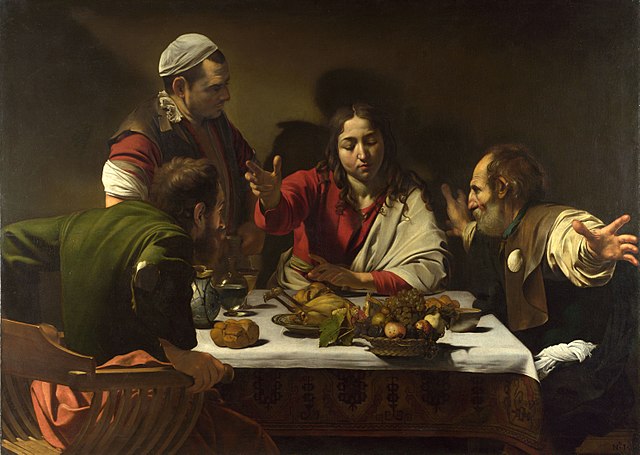
The Supper at Emmaus was painted around 1601 and is presently housed in the National Gallery in London. Originally, Ciriaco Mattei, key Girolamo Mattei's brother, commissioned and paid for this artwork.
The artwork shows the moment when the resurrected but bearded Jesus appears to two of his followers (possibly Luke and Cleopas) in the hamlet of Emmaus, only to quickly disappear from their view. Cleopas is dressed in a pilgrim's scallop crush.
The other apostle is dressed in ragged garments. Cleopas gesticulates by extending his artillery in and out of his frame of reference. The standing groom, with a smooth brow and a darkened confront, looks indifferent to the situation.
The picture is remarkable in that information technology has life-size characters on a nighttime, blank backdrop. A notwithstanding-life lunch is laid out on the table. As with the world they knew, the basket of food teeters precariously close to the precipice.
In 1606 Caravaggio painted some other version of the Supper at Emmaus (currently in Milan's Brera). By dissimilarity, figures' motions are significantly more restrained, emphasizing presence over performance.
Both versions use the Trompe-l'il method, which seems to enable characters to move in their movements in order to capture the viewer's attending.
Source: https://www.artst.org/caravaggio-paintings/
0 Response to "10 Most Famous Caravaggio Paintings"
Post a Comment